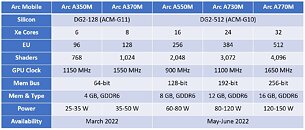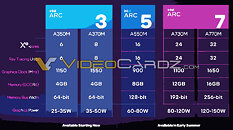- Joined
- Oct 9, 2007
- Messages
- 47,585 (7.45/day)
- Location
- Dublin, Ireland
| System Name | RBMK-1000 |
|---|---|
| Processor | AMD Ryzen 7 5700G |
| Motherboard | ASUS ROG Strix B450-E Gaming |
| Cooling | DeepCool Gammax L240 V2 |
| Memory | 2x 8GB G.Skill Sniper X |
| Video Card(s) | Palit GeForce RTX 2080 SUPER GameRock |
| Storage | Western Digital Black NVMe 512GB |
| Display(s) | BenQ 1440p 60 Hz 27-inch |
| Case | Corsair Carbide 100R |
| Audio Device(s) | ASUS SupremeFX S1220A |
| Power Supply | Cooler Master MWE Gold 650W |
| Mouse | ASUS ROG Strix Impact |
| Keyboard | Gamdias Hermes E2 |
| Software | Windows 11 Pro |
Intel is preparing to debut the Arc "Alchemist" line of graphics processors with a mobile-first approach, where the company leverages its bulletproof relations with notebook manufacturers to use its discrete mobile GPUs to go with their 12th Gen Core "Alder Lake" processors. These will be launch in two tranches, with the first round expected as early as today (March 30), according to a VideoCardz report citing a leaked company slide. The series will debut with the Arc 3 series of entry-level discrete GPUs, before moving onto the mid-range Arc 5 and premium Arc 7 series "early summer" (we read that as May-June, 2022).
The entire lineup of Arc "Alchemist" is based on two ASICs, the smaller one is the ACM-G11, or DG2-128; while the larger one is the ACM-G10, or DG2-512. The former comes with 128 execution units (EU), while the larger one has 512 EU. The Arc 3 series, consisting of the A350M and A370M, come with 96 and 128 EU (768 and 1,024 unified shaders), respectively, The mid-range Arc A550M is based on the lowest trim of the DG2-512, with half its EU count disabled (256 EU, or 2,048 shaders). The Arc A730M has three-fourths of the EU count enabled, while the A770M maxes it out.


What's interesting is the memory configuration for the Arc 3 series, which sees just 4 GB of it, across a 64-bit memory bus. The A550M gets a respectable 8 GB across 128-bit, the A730M has 12 GB across 192-bit, and the top-dog A770M maxes out the 256-bit wide memory bus, with an impressive 16 GB of memory. Intel will debut these GPUs with the company's Deep Link technology, which allows the Xe HPG discrete GPU and an Xe-LP based iGPU in "Alder Lake" processors to work in greater collaboration, including a form of implicit asymmetric multi-GPU, with pooled power-budgets (Intel Dynamic Power Share) and resource-sharing in not just gaming, but also video encoding (Intel Hyper Encode). The Xe HPG graphics architecture will be Intel's first with DirectX 12 Ultimate readiness, including real-time ray tracing. It will also debut the XeSS (Xe Super Sampling) performance enhancement feature, which is functionally analogous to AMD FSR or NVIDIA DLSS.

View at TechPowerUp Main Site | Source
The entire lineup of Arc "Alchemist" is based on two ASICs, the smaller one is the ACM-G11, or DG2-128; while the larger one is the ACM-G10, or DG2-512. The former comes with 128 execution units (EU), while the larger one has 512 EU. The Arc 3 series, consisting of the A350M and A370M, come with 96 and 128 EU (768 and 1,024 unified shaders), respectively, The mid-range Arc A550M is based on the lowest trim of the DG2-512, with half its EU count disabled (256 EU, or 2,048 shaders). The Arc A730M has three-fourths of the EU count enabled, while the A770M maxes it out.


What's interesting is the memory configuration for the Arc 3 series, which sees just 4 GB of it, across a 64-bit memory bus. The A550M gets a respectable 8 GB across 128-bit, the A730M has 12 GB across 192-bit, and the top-dog A770M maxes out the 256-bit wide memory bus, with an impressive 16 GB of memory. Intel will debut these GPUs with the company's Deep Link technology, which allows the Xe HPG discrete GPU and an Xe-LP based iGPU in "Alder Lake" processors to work in greater collaboration, including a form of implicit asymmetric multi-GPU, with pooled power-budgets (Intel Dynamic Power Share) and resource-sharing in not just gaming, but also video encoding (Intel Hyper Encode). The Xe HPG graphics architecture will be Intel's first with DirectX 12 Ultimate readiness, including real-time ray tracing. It will also debut the XeSS (Xe Super Sampling) performance enhancement feature, which is functionally analogous to AMD FSR or NVIDIA DLSS.

View at TechPowerUp Main Site | Source







 (their GPU program is having a really rough start lol)
(their GPU program is having a really rough start lol)